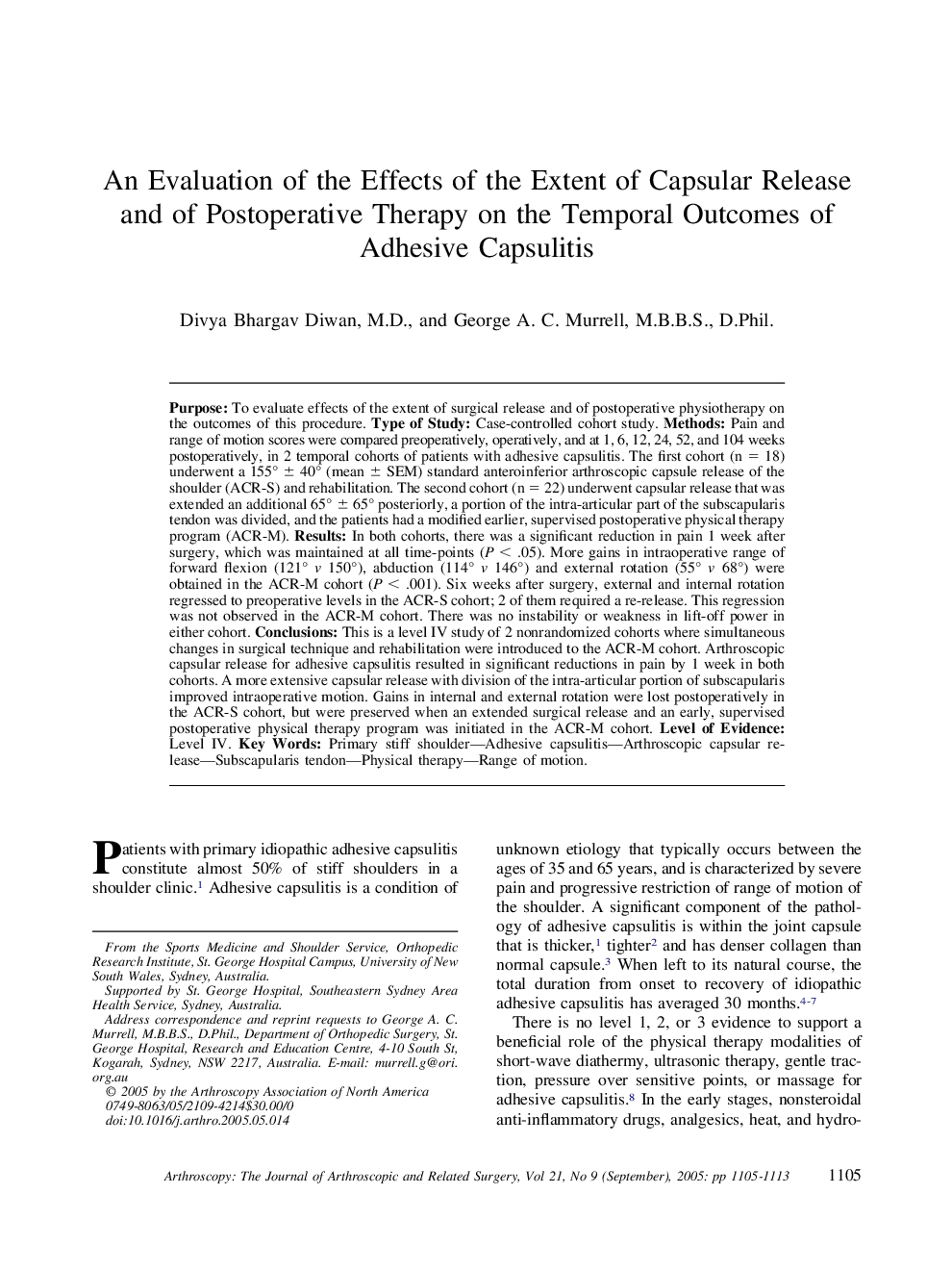| کد مقاله | کد نشریه | سال انتشار | مقاله انگلیسی | نسخه تمام متن |
|---|---|---|---|---|
| 10078867 | 1603619 | 2005 | 9 صفحه PDF | دانلود رایگان |
عنوان انگلیسی مقاله ISI
An Evaluation of the Effects of the Extent of Capsular Release and of Postoperative Therapy on the Temporal Outcomes of Adhesive Capsulitis
دانلود مقاله + سفارش ترجمه
دانلود مقاله ISI انگلیسی
رایگان برای ایرانیان
کلمات کلیدی
موضوعات مرتبط
علوم پزشکی و سلامت
پزشکی و دندانپزشکی
ارتوپدی، پزشکی ورزشی و توانبخشی
پیش نمایش صفحه اول مقاله

چکیده انگلیسی
Purpose: To evaluate effects of the extent of surgical release and of postoperative physiotherapy on the outcomes of this procedure. Type of Study: Case-controlled cohort study. Methods: Pain and range of motion scores were compared preoperatively, operatively, and at 1, 6, 12, 24, 52, and 104 weeks postoperatively, in 2 temporal cohorts of patients with adhesive capsulitis. The first cohort (n = 18) underwent a 155° ± 40° (mean ± SEM) standard anteroinferior arthroscopic capsule release of the shoulder (ACR-S) and rehabilitation. The second cohort (n = 22) underwent capsular release that was extended an additional 65° ± 65° posteriorly, a portion of the intra-articular part of the subscapularis tendon was divided, and the patients had a modified earlier, supervised postoperative physical therapy program (ACR-M). Results: In both cohorts, there was a significant reduction in pain 1 week after surgery, which was maintained at all time-points (P < .05). More gains in intraoperative range of forward flexion (121° v 150°), abduction (114° v 146°) and external rotation (55° v 68°) were obtained in the ACR-M cohort (P < .001). Six weeks after surgery, external and internal rotation regressed to preoperative levels in the ACR-S cohort; 2 of them required a re-release. This regression was not observed in the ACR-M cohort. There was no instability or weakness in lift-off power in either cohort. Conclusions: This is a level IV study of 2 nonrandomized cohorts where simultaneous changes in surgical technique and rehabilitation were introduced to the ACR-M cohort. Arthroscopic capsular release for adhesive capsulitis resulted in significant reductions in pain by 1 week in both cohorts. A more extensive capsular release with division of the intra-articular portion of subscapularis improved intraoperative motion. Gains in internal and external rotation were lost postoperatively in the ACR-S cohort, but were preserved when an extended surgical release and an early, supervised postoperative physical therapy program was initiated in the ACR-M cohort. Level of Evidence: Level IV.
ناشر
Database: Elsevier - ScienceDirect (ساینس دایرکت)
Journal: Arthroscopy: The Journal of Arthroscopic & Related Surgery - Volume 21, Issue 9, September 2005, Pages 1105-1113
Journal: Arthroscopy: The Journal of Arthroscopic & Related Surgery - Volume 21, Issue 9, September 2005, Pages 1105-1113
نویسندگان
Divya Bhargav M.D., George A.C. M.B.B.S., D.Phil.,